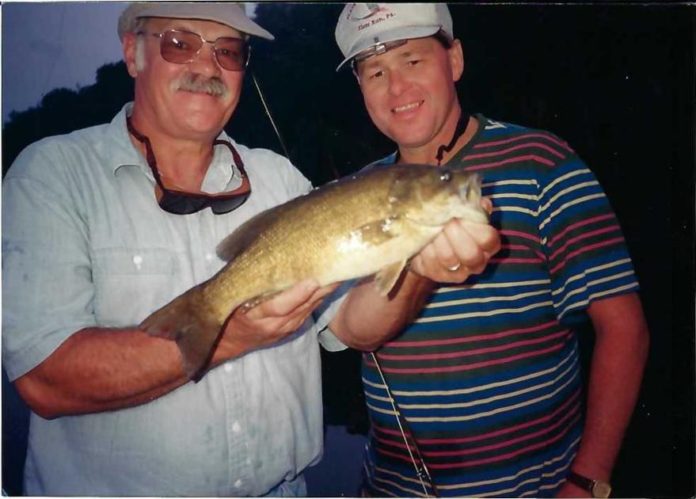The renowned Bob Clouser, creator of the famed Clouser Minnow fly pattern, was the featured speaker at the May meeting of the Potomac Valley Fly Fishers. The Clouser Minnow fly pattern is known world-wide and has caught more varieties of fish than any other fly in both fresh and saltwater. The meeting was held virtually due to pandemic restrictions as Clouser presented from his home in Cocoa, Florida.
Around 1990, PVFF member Rick Loose began fishing with Clouser on the Susquehanna River for smallmouth bass after reading an article written by the late Lefty Kreh in the Baltimore Sun that recommended Clouser’s guide service. Guided trips on the Susquehanna with Clouser became annual and semiannual trips for Loose and his brother and often included other guests.
Loose introduced Clouser to the attendees of the virtual meeting and qualified him as “the best guide I have ever been with … he is a great teacher, a great fly caster and one helluva an innovator in fly tying as well as an outdoor writer and photographer.” Reflecting on his long career as a fly fishing guide, Clouser quipped, “I never thought I would live this long … I will be 83 in November, and I’m still fishing!”
Loose went on to describe a humorous comment Clouser made during a productive morning of bass fishing.
“Bob had a big jon boat and he used a long pole to push us around the river while we fished. I made the off-handed remark about what he thought the poor people were doing that day,” said Loose. Clouser sneered, “I’ll tell you what the poor people are doing, they’re poling this damn boat!”
Tying a Clouser Minnow
Clouser began his presentation with a fly tying demonstration of a Clouser Half & Half streamer fly, which is a favorite for striper guides.
“It looks like a Clouser minnow with Lefty’s feathers in the middle,” said Clouser, referring to the long hackle feathers that are prominent in the Lefty’s Deceiver fly pattern. Kreh and Clouser were close friends.
Clouser then began a detailed step-by-step demonstration. He started by attaching lead dumbbell eyes painted red at one third of the distance from the eye of a size 2 hook. He recommends Ahrex brand hooks because of the hook strength and smoothness.
The eyes were attached securely by using a cross-wrap technique rather than figure eight wraps. He then added hackles behind the eyes by selecting nice, straight feathers, not twisted. The hackles were carefully stacked together with the concave sides facing each other. He recommended not pulling off the lower hackle fibers as the bare stems tend to twist when attached to the hook.
Next, a collar of white bucktail was wrapped behind the eyes so the hair fibers flared backward around the hook. The tying thread was then advanced to the front of the eyes. Yellow bucktail was added down the length of the fly on top, then some crystal flash and finally a layer of chartreuse bucktail. The head was whip-finished before a coating of UV sealant was applied. He explained that he used to use epoxy until he discovered Solarez, which cures instantly with a blue light and is just as durable as epoxy.
Clouser held up the finished fly to the camera and said, “There is the half & half … pretty simple fly but very deadly. Chartreuse and yellow mix with gold flash will work 99 percent of the time … Chartreuse and white works just as good or plain olive over white, and many guides tell me the gray over white is the best, but I disagree. I like the chartreuse and yellow.”
He then inquired if anybody had been fishing on the Susquehanna near his hometown in Middletown, Pennsylvania. He stopped guiding on the Susquehanna in 2009 due to the low numbers of bass.
“There has been no bass from Harrisburg to Middletown [Pennsylvania] the last couple of years. … The pollution from Harrisburg is the problem, I suspect. It was nothing to catch 100 fish a day. The last time we fished it, we had a hard time catching 20 a day in the same area. … It’s a shame.
“If you go above Harrisburg by Marysville, you will still find some fish.”
Casting for accuracy
Learning how to make a mend before the fly hits the water is a casting technique that Clouser intends to record in a video.
“I learned over time to be able to make the mend in the air with a straight high cast. When the fly line hits the water, the fly doesn’t pull away from the target and you do not have to make any more mends,” Clouser said.
His presentation had many other great tips on fishing for smallmouth and largemouth bass, including techniques for bottom fishing by nymphing or dead drifting flies and topwater by using popping bugs.
After the meeting, I asked Loose what he enjoyed most about his experiences with Clouser.
“Probably first and foremost the fishing was really good and the white miller hatch was crazy good,” Loose said. “Second, Bob is a great teacher. In the early days, since my brother and I had just started to fly fish, it was mainly casting, but later we learned about the river, weather, water conditions, you name it. Bob became more of a friend than a guide. His fly shop was connected to his house, so we got to know his family. His late wife Joan and son Bobby Jr. worked in the shop. His son Michael had Down syndrome and was always around to greet us with a hug.”
Clouser has also developed numerous other innovative and highly productive patterns, all of which you can find for sale in the Freshwater Flies and Saltwater Flies section of his website: https://clousersflyshop.com/home.
Credit: Source link






























